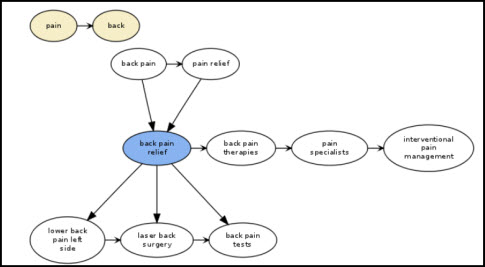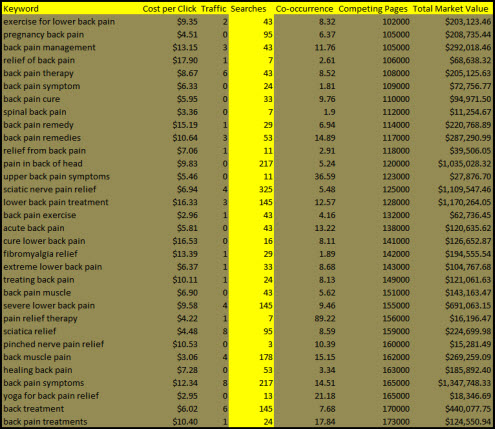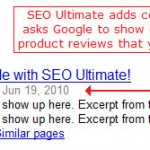The primary reason why people use search engines is to find answers. Therefore, your websites success depends on whether or not you fully understand the questions people are searching for (the cause behind the cause) and to which degree your landing pages answer those questions or solve their problems.
This is known as finding the pain (as the image clearly illustrates above) and serving up the perfect pain killer is a prime directive for conversion.
In fact, this feedback/cycle of problem/solution, seek and satiate the query / modality is hard-wired into the human psyche and represents the springboard for landing pages and high conversions – if the context of why they are searching is present and if those pages deliver the proper solution to the prospect at the right time in the sales cycle.
If proper timing, relevance and value converge (from users finding their solution), the end result is a predictable / natural conclusion, i.e. a sale, opt in or predictive action. This is where search engine optimization, (much like a game of chess) gets interesting. Many often make the mistake of targeting one keyword vs. targeting multiple keywords and devouring the online conversation through including tactful modifiers, synonyms or commercially laden suggestive phrases in tandem with primary keywords.
If you logically target a cluster of phrases that overlap and have continuity, the likelihood of your website or landing page appearing on multiple nodes of the search /solution phase when people are most impressionable are increased.
In other words, if you can span the gamut from the niche oriented long tail phrases, up through the category defining popular phrases and breach the primary educational queries with well positioned content, the you own the conversation for that market.
3 Painful Keyword Research Pitfalls
Rather than tell you what to do, let’s start out with a few examples of keyword research pitfalls to avoid.
- Not understanding your audience.
- Not understanding the difference between profitable/lucrative keywords and keyword “duds”.
- Failing to implement a bridge that effectively communicates value to the ideal prospect (or communicating the wrong message to the wrong audience).
Using the gentlemen in the image above, I can assure you he is not looking for “a book about back pain”, he is “looking for relief”, quickly! Trying to sell him something preventative (after the fact, is a perfect example of wrong product, wrong time, wrong prospect.
Someone who injured their back slightly and is showing minor symptoms or is considering long-term recovery options however, may benefit from an e-book or alternate method (something less urgent). So, to rule out an e-book “back pain relief” / offer is not senseless, it merely requires a different tact and appeals to a different node and demands its own place within the site architecture.
1. Not Understanding Your Audience
Rather than go into a lengthy discussion on the value of context. Rest assured that while people use a vast array of keywords, their intention is the driving factor of why they are searching rather than the phrases. Just consider keywords as doors that represent the gateway to your audience in search engines.
They are either hit or miss and picking the wrong keywords or saying the wrong thing to the wrong prospect (from lack of continuity or otherwise) will not compensate for delving deeper to find the right keywords initially to build your keyword / content framework on.
Your job as a business owner, entrepreneur or webmaster is to vet and extract the most profitable phrases and weave them into your titles meta descriptions, landing pages, header tags, internal links and inbound links so that your website can appear when those searches are conducted. Yet, if you are basing your data gathering on shallow methods, inevitably, the outcome is less than desirable.
There are many ways to extract meaning from a market such as keyword research, competitor research or vertical online market analysis. However, regardless of your method, the following two rules below still apply.
2. The Difference Between Profitable Keywords and Duds
Profitable keywords are not always high traffic volume keywords. You have to understand the question behind the question and appeal to the emotion of the prospect. Value, message match and conversion are important, but if you target the wrong keywords you will never have enough traffic to measure genuine click-throughs in search engines enough to have a valid sample set in which to base present and/or future campaigns.
3. Communicating the Right Message to the Right Audience
To ensure landing pages convert, they should have a sole purpose (to rank for their primary phrase) as determined by where they fit into your industry solution. Keywords can either hit or miss their target and someone searching for something may find it using 100 different keyword variations but men the same thing). This is why you need to map out the most lucrative phrases and then weave a web of relevance through internal links and deep links from other websites.
This process is called keyword stemming (getting a keyword ranked and then using it to spawn dozens, hundreds or thousands of keywords), and by design it is one of the most effective SEO strategies ever devised.
However, to do this deliberately from the onset (like a game of chess unfolding vs. an accidental / circumstantial happenstance) is what differentiates hardcore SEO from neophyte SEO’s throwing darts against the wall with keywords in an attempt to make things stick (and then using a fragmented approach to attempt to rank them).
Organic rankings take time and the last thing you can afford is to focus on keyword duds. Every dollar, link or article you invest should have ROI as the basis. Observing the cluster of phrases and planning a point of entry and plotting your keyword roll-out / development plan is one of the most critical parts of initiating any SEO campaign.
Attention share translates into brand awareness and that brand awareness is the cornerstone to trust and engagement. But let’s get out of the theoretical zone and get down to brass tacks with some viable examples of this modality.
Understanding Informational vs. Commercial Queries
Answers that pertain to problems are opportunities in disguise. The difference between a sale and an informative query often appear quite similar, but in fact, it’s the subtle nuances that distinguish a conversion laden search from a mere query for more information.
You would be surprised how many questions you can find from skimming the analytics of an authority site or even using SEO tools like SEMRush to find out what type of long-tail and mid-tail queries your competitors are already ranking for. You can uncover lots of low hanging fruit and these keywords are “effective keywords” considering they are already responsible for driving traffic (not just grasping at straws unfounded).
Let’s use “back pain” as an example and discuss the two types of queries which one could use to create revenue. One is informational the other is commercial, we will look at both.

Semantic Keyword Cluster for Back Pain
Informational queries tend to be broad in nature. An example of a “broad search” can be represented by someone searching for information on a “herniated disc” or a “hernia” vs. someone searching for “pain relief from hernia” or “how to relieve back pain”. The operative distinction is the use of the modifier relief, relieve, treatment, etc. which represents a more urgent need for a “pain killer/solution”.
From the outside in, as a business owner, you might think your keyword is “back pain”, but there are two considerations to this quandary; (1) the root phrase is the most competitive and (2) you still need to drill deeper into the solution to find the real “pain killer” queries and triggers that will distinguish your offer / landing page from the masses.
You also need to consider that for any “competitive” keyword query, that keyword will need more supporting articles, shingles and instances within a website in order for that website to be considered a valid destination (based on the search engines stringent quality score algorithm).
This means that for one competitive keyword, you may need hundreds of supporting articles (based on the rungs in the ladder/synonyms and modifiers for the topic) to gain enough authority to rank for that competitive keyword.
While many see this as a burden, on the contrary, this is a genuine opportunity for implementing the process of progressive layering of multiple nodes of relevance through content creation by using the less competitive queries (which you can devour along the way) on your way up the food chain to the more lucrative traffic from the root phrase.
Also, keep in mind that more broad traffic (like a flashlight) is not always going to convert higher than a pin-point targeted message and value proposition with a more specific (laser-like) query. So, instead of chasing volume with keywords, chase value (by using tactics like these)…
Chasing Search Value Not Search Volume
After you map out the pain points, you can use magnetic headlines coupled with value propositions to do this such as:
- 3 Proven Tips to Alleviate Back Pain in 10 Minutes or Less.
- 5 Things to Avoid Inflaming Lower Back Pain.
- 4 Foods You Can Eat to Decrease Back Pain.
The use of tactful modifiers and compelling solution based keywords coupled with the primary phrase now provide the context to ensure that your audience is filtered out by default.
You will only attract those looking for “the right solution” which means two things (1) less tire kickers hit your page and (2) the people that do click are more apt to convert. So, instead of you having a measly 1% conversion (1 out of 100 people engaging your offer, opting in to your e-book, or buying your product) can increase to 6-10% conversion or higher (depending on factors such as (a) the graphic appeal (b) the validity of your product (c) trust signals (d) relevance and (e) timing.
The takeaway here is to be specific but look for overlapping synonyms which are all tell tale symptoms of the problem.
I would also scrub the cluster of keywords and find other lucrative missed opportunities to use for additional categories, supporting articles and solutions which need to be addressed for that audience.

Other Theme Relevant Keywords from Back Pain Cluster
Once I found the DNA braid of phrases, I would then logically plot out the stages for market domination using tools like those offered in the Network Empire and provided by tools like the Krakken (not for flimsy SEO’s) these are professional grade tools for those who are serious about taking over markets.
10 Keyword Research Tips
You will need to know:
1) Who your audience is?
2) What they need?
3) How they find what they need (how they search)… and once you unearth that –
4) How to build your industry solution
5) Which keywords are critical or supportive
6) Where they fit into your website’s hierarchy and what emphasis they garner (internal links and / or link building).
7) What type of conversion the objective is (informational) such as an e-book or link to a paid e-book/affiliate offer, physical products (either sold on site or linked from your site to others affiliate offers), CPA or CPL (cost per acquisition or cost per lead) if there are national businesses that will pay for leads or local businesses who can benefit directly from that traffic (with your site as a portal).
8) How long it will take for you to build enough content, internal links, deep links from other sites, traffic and see ROI.
9) A method to map out each keyword, site architecture, internal links, link building and syndication strategy.
10) A process to manage it.
All of those things can be found at www.networkempire.com and you would be wise to join and either be a fly on the wall or start using the tools there to uncover and conquer organic online markets.
I hope you found this post useful and as always, thanks for reading the SEO Design Solutions Blog. Stay tuned for the WP Ultimate theme launch shortly. We have been quiet for over a month now as we prepare our new WordPress theme / framework. It’s nearly ready, so bear with us as we stress test the application prior to the initial launch.












Great Article. Such a simple concept that I / we all need to be reminded of on a monthly / daily basis.
Agreed Dale:
Finding the pain/solution open/closed loop is like reducing everything to simplicity (on/off) is or is not (relevant) to those caught in the cycle.
Thanks for commenting.
All the best!
I do like the article, we have not done any keyword analysis or targeting. It looks like this will be our next approach to getting noticed.
Great Info thanks for sharing
Sure thing Steve, thank you for visiting.
All the best!
Another thing to consider when doing keyword research is that you want to make sure that you make sure for the search volume you use the exact search when using the Google Keyword Tool.
Like the first guy said, it good to get reminded about this AGAIN! I have been upgrading 3 of my sites and i,m no website genius, just when you finished putting your products on, you think your finished. Oh No! you are just at the beginning! Its hard work, good article! keep tapping away on those keys
This was definitely worth reading. Found the link on your WordPress SEO plugin :)
@Van:
Thanks a lot, glad you are enjoying SEO Ultimate and now the blog as well.
All the best!
Jeffrey